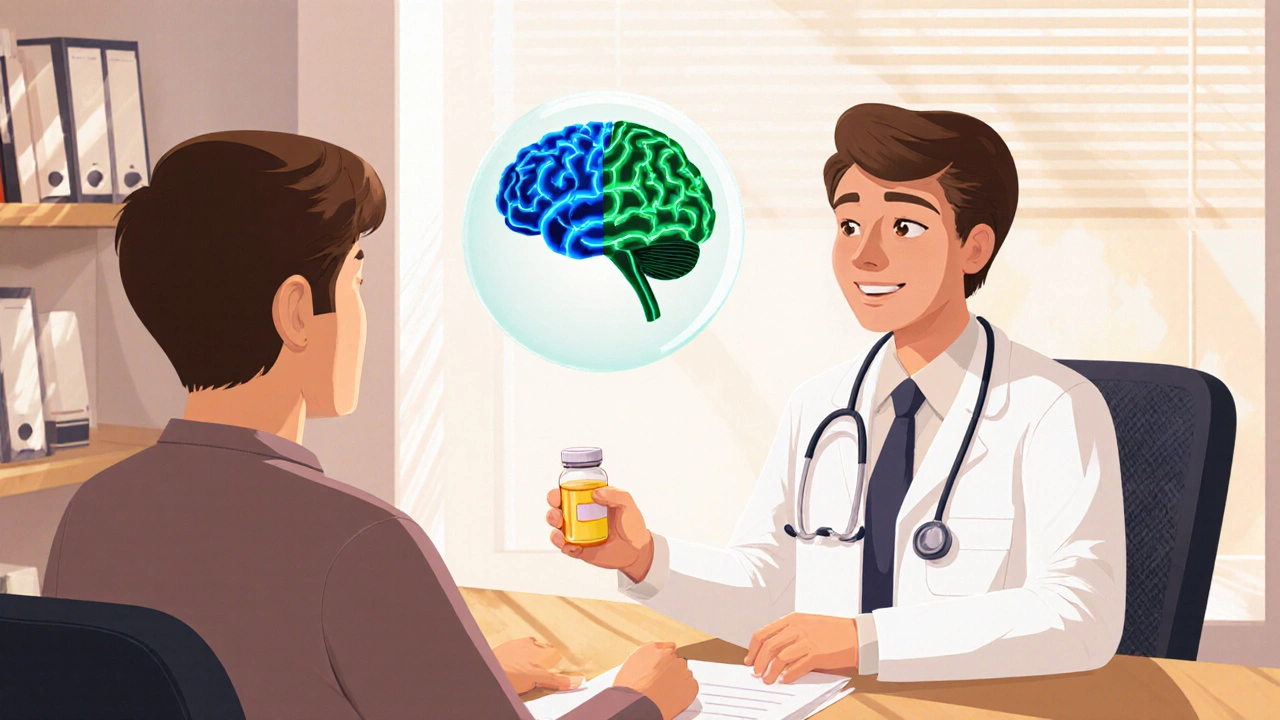Aripiprazole Side Effect Risk Calculator
Side Effect Risk Assessment
This calculator estimates your potential risk of side effects based on clinical evidence and individual factors. Remember, actual results may vary.
When doctors consider adding Aripiprazole an atypical antipsychotic that modulates dopamine and serotonin activity to a depression regimen, they weigh the potential for symptom relief against side‑effect risks. The question on many patients' minds is simple: aripiprazole depression - can this pill really lift a low mood?
What Is Aripiprazole and How Does It Work?
Aripiprazole (brand name Abilify) belongs to a class called serotonin‑dopamine activity modulators (SDAMs). Unlike traditional antipsychotics that block dopamine outright, aripiprazole works as a partial agonist at dopamine D2 receptors and serotonin 5‑HT1A receptors while antagonising 5‑HT2A receptors. In plain language, it helps balance neurotransmitters rather than shutting them down.
This balancing act can improve mood, motivation, and cognition - the three symptom clusters most often crippled in Major Depressive Disorder (MDD). By fine‑tuning dopamine, aripiprazole can reduce anhedonia (loss of pleasure) and sluggish thinking, while serotonin effects help with anxiety and sleep.
Why Consider Aripiprazole for Depression?
Standard first‑line treatments for MDD are selective serotonin reuptake inhibitors (SSRIs) or serotonin‑noradrenaline reuptake inhibitors (SNRIs). About a third of patients don’t achieve remission with these drugs alone. That’s where an "adjunctive" strategy comes in - adding another medication to boost the primary antidepressant.
Regulatory agencies like the FDA have approved aripiprazole as an add‑on for treatment‑resistant depression. Clinical trials (e.g., the 2010STAR*D sub‑study) showed that patients taking an SSRI plus aripiprazole had a 44% remission rate versus 25% with SSRI alone.
Evidence from Clinical Trials
Several double‑blind, placebo‑controlled studies have evaluated aripiprazole as an adjunct. Key findings include:
- Response rates: 35‑45% improvement in Hamilton Depression Rating Scale (HAM‑D) scores versus 20‑30% for placebo.
- Time to effect: Most benefit observed after 4‑6weeks of steady dosing.
- Population: Trials included adults aged 18‑65 with MDD that had failed at least one antidepressant trial.
Meta‑analyses published up to 2023 confirm that aripiprazole adds roughly 0.5 points to the standardized mean difference (SMD) for remission compared with placebo‑add‑on. The effect size is modest but clinically meaningful for those stuck in chronic low mood.

How to Dose Aripiprazole When Used for Depression
Because aripiprazole was originally designed for schizophrenia, its depression dosing starts low to minimise side‑effects.
- Start: 2mg once daily, usually taken in the morning.
- titration: Increase by 2mg weekly if tolerated, aiming for a target of 5‑10mg per day.
- Maximum: Most trials cap at 15mg; higher doses don’t show extra mood benefit but raise risk of akathisia.
Always combine with a stable dose of the primary antidepressant - switching both drugs simultaneously can confuse side‑effect attribution.
Potential Benefits and Risks
Benefits (when the drug works as intended):
- Reduced anhedonia and emotional numbness.
- Improved energy and executive function.
- Lowered anxiety levels thanks to serotonin antagonism.
Common side‑effects (affect up to 20% of users):
- Akathisia - a restless, jittery feeling.
- Insomnia or vivid dreams.
- Gastrointestinal upset (nausea, constipation).
Serious risks that warrant monitoring:
- Metabolic changes - slight weight gain and elevated triglycerides.
- Extrapyramidal symptoms, including tardive dyskinesia (infrequent but irreversible).
- Elevated prolactin levels, which can lead to menstrual irregularities.
Because aripiprazole crosses the blood‑brain barrier efficiently, any systemic changes appear quickly in the central nervous system. Regular labs (fasting lipid panel, fasting glucose) and movement‑disorder assessments are advisable every 3‑6months.
How Does Aripiprazole Stack Up Against Other Adjuncts?
| Medication | Typical Dose (mg) | Key Mechanism | Evidence Strength | Common Side‑Effects |
|---|---|---|---|---|
| Aripiprazole | 5‑10 | Partial D2/5‑HT1A agonist, 5‑HT2A antagonist | High (multiple RCTs) | Akathisia, insomnia, weight gain |
| Quetiapine | 150‑300 | Broad serotonin‑dopamine antagonist | Moderate (few large RCTs) | Sedation, orthostatic hypotension, metabolic syndrome |
| Brexpiprazole | 1‑3 | Partial D2/5‑HT1A agonist, 5‑HT2A antagonist (similar to aripiprazole) | Emerging (phase‑III data) | Weight gain, akathisia, dizziness |
| Lithium (add‑on) | 300‑900 | Neuroprotective & mood‑stabilising | High (long‑term studies) | Thyroid, kidney, tremor |
When choosing, consider the patient’s medical history. For example, a person already battling obesity might avoid quetiapine due to its strong metabolic footprint, while aripiprazole’s modest weight impact could be a better fit.
Practical Tips for Patients and Clinicians
Below is a quick checklist to keep the treatment journey smooth:
- Set a realistic timeline - expect 4‑6weeks before judging effectiveness.
- Start low, go slow - the 2mg start helps identify tolerance.
- Monitor movement - report any restlessness, facial grimacing, or tongue‑biting.
- Track weight and labs - schedule a fasting lipid/glucose panel after 3months.
- Maintain open communication - adjust the dose only after discussing benefits vs side‑effects.
Don’t forget non‑pharmacologic supports. Combining aripiprazole with Cognitive Behavioral Therapy (CBT) often yields higher remission rates than medication alone.
Bottom Line
Aripiprazole isn’t a first‑line antidepressant, but it can be a valuable ally for people whose mood hasn’t bounced back after standard therapy. The drug’s unique pharmacology offers a chance to lift the emotional “flatness” that many antidepressants miss, though the trade‑off is a careful watch for restlessness and metabolic changes. Talk with a prescriber about whether the benefits outweigh the risks for your specific situation.
Frequently Asked Questions
Can aripiprazole be used alone for depression?
No. The drug is approved only as an adjunct, meaning it must be added to an existing antidepressant. Using it alone hasn’t shown consistent benefit and increases side‑effect risk.
How long should I stay on aripiprazole if it helps?
Most clinicians aim for at least 6‑12months of stable remission before considering taper. A slow down‑taper (reducing 2mg every 2‑3weeks) helps avoid rebound anxiety or withdrawal symptoms.
What is akathisia and how is it managed?
Akathisia feels like inner restlessness - you can’t sit still. Treatment options include dose reduction, adding a low‑dose beta‑blocker (propranolol), or a benzodiazepine for short‑term relief.
Is aripiprazole safe during pregnancy?
Animal data show no major teratogenic effects, but human data are limited. The FDA classifies it as CategoryC - use only if benefits outweigh potential risks and after consulting a specialist.
How does aripiprazole differ from quetiapine as an adjunct?
Aripiprazole has a milder metabolic profile and is less sedating, while quetiapine often causes daytime drowsiness but may help patients with comorbid insomnia. Choice depends on individual side‑effect tolerance and co‑existing conditions.


Samantha Oldrid
Oh great, another pill that promises heaven while the pharma giants pull the strings behind the curtain.